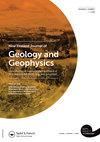The ‘Gulliver’ fish fauna of an early Miocene freshwater system of New Zealand; new insights from otoliths from the Bannockburn Formation
IF 1.9
4区 地球科学
Q1 GEOLOGY
New Zealand Journal of Geology and Geophysics
Pub Date : 2023-01-02
DOI:10.1080/00288306.2022.2153878
引用次数: 1
Abstract
ABSTRACT The early Miocene palaeolake Manuherikia in Central Otago, South Island, New Zealand is a prime source for reconstructing the terrestrial and freshwater biota of past Zealandia. Otoliths of fishes that once lived in this lake system were first described in 2012. Here we report the results of extensive additional sampling resulting in a total of 16,500 fish otoliths from a wide set of stratigraphic levels and environmental settings within the Bannockburn Formation near St Bathans. Six new species are described: Galaxias crassus, Galaxias naviculus, Galaxias nitidus, Galaxias polei, Galaxias tholus, Mataichthys asymmetricus. The entire freshwater otolith-based fish fauna of the Bannockburn Formation now encompasses 17 species, 10 in Galaxiidae, 2 in Prototroctidae and 5 in Eleotridae; all families present in the freshwater systems of New Zealand today. Correlation with putative related extant taxa reveal that the fishes from the Bannockburn Formation were relatively large, often at the upper margin of the extant sizes of fishes in the respective groups or even larger. This ‘Gulliver’ fish fauna is consistent with other fossil and extant ‘gulliverisms’ observed in various Zealandian biota. Environmental and putative evolutionary explanations, aspects of the taphocoenosis and possible stratigraphic implications of the otolith assemblages are discussed.新西兰中新世早期淡水系统的“格列佛”鱼类区系;Bannockburn组耳石的新发现
新西兰南岛奥塔哥中部的Manuherikia早中新世古湖泊是重建过去西兰洲陆地和淡水生物群的主要来源。2012年首次描述了曾经生活在这个湖泊系统中的鱼类的耳石。在这里,我们报告了大量额外采样的结果,从圣巴坦附近的班诺克本地层和环境设置中获得了16,500块鱼耳石。描述了6个新种:克拉苏星系、naviculus星系、nitidus星系、polei星系、tholus星系、Mataichthys asymmetricus星系。整个班诺克本组以耳石为基础的淡水鱼类区系现在包括17种,其中10种为银河鱼科,2种为原栉鱼科,5种为栉鱼科;今天新西兰淡水系统中的所有科与推测的相关现存分类群的对比表明,班诺克本组的鱼类体型相对较大,通常处于各自类群中现存鱼类体型的上边缘,甚至更大。这种“格列佛”鱼动物群与在新西兰各种生物群中观察到的其他化石和现存的“格列佛主义”是一致的。讨论了耳石组合的环境和演化解释、耳石凝聚作用的各个方面以及可能的地层意义。
本文章由计算机程序翻译,如有差异,请以英文原文为准。
求助全文
约1分钟内获得全文
求助全文
来源期刊
CiteScore
5.10
自引率
27.30%
发文量
34
审稿时长
>12 weeks
期刊介绍:
Aims: New Zealand is well respected for its growing research activity in the geosciences, particularly in circum-Pacific earth science. The New Zealand Journal of Geology and Geophysics plays an important role in disseminating field-based, experimental, and theoretical research to geoscientists with interests both within and beyond the circum-Pacific. Scope of submissions: The New Zealand Journal of Geology and Geophysics publishes original research papers, review papers, short communications and letters. We welcome submissions on all aspects of the earth sciences relevant to New Zealand, the Pacific Rim, and Antarctica. The subject matter includes geology, geophysics, physical geography and pedology.

 求助内容:
求助内容: 应助结果提醒方式:
应助结果提醒方式:


